Growth of Export Market in Australian Agricultural Sector
VerifiedAdded on 2021/06/16
|11
|1554
|218
AI Summary
Contribute Materials
Your contribution can guide someone’s learning journey. Share your
documents today.
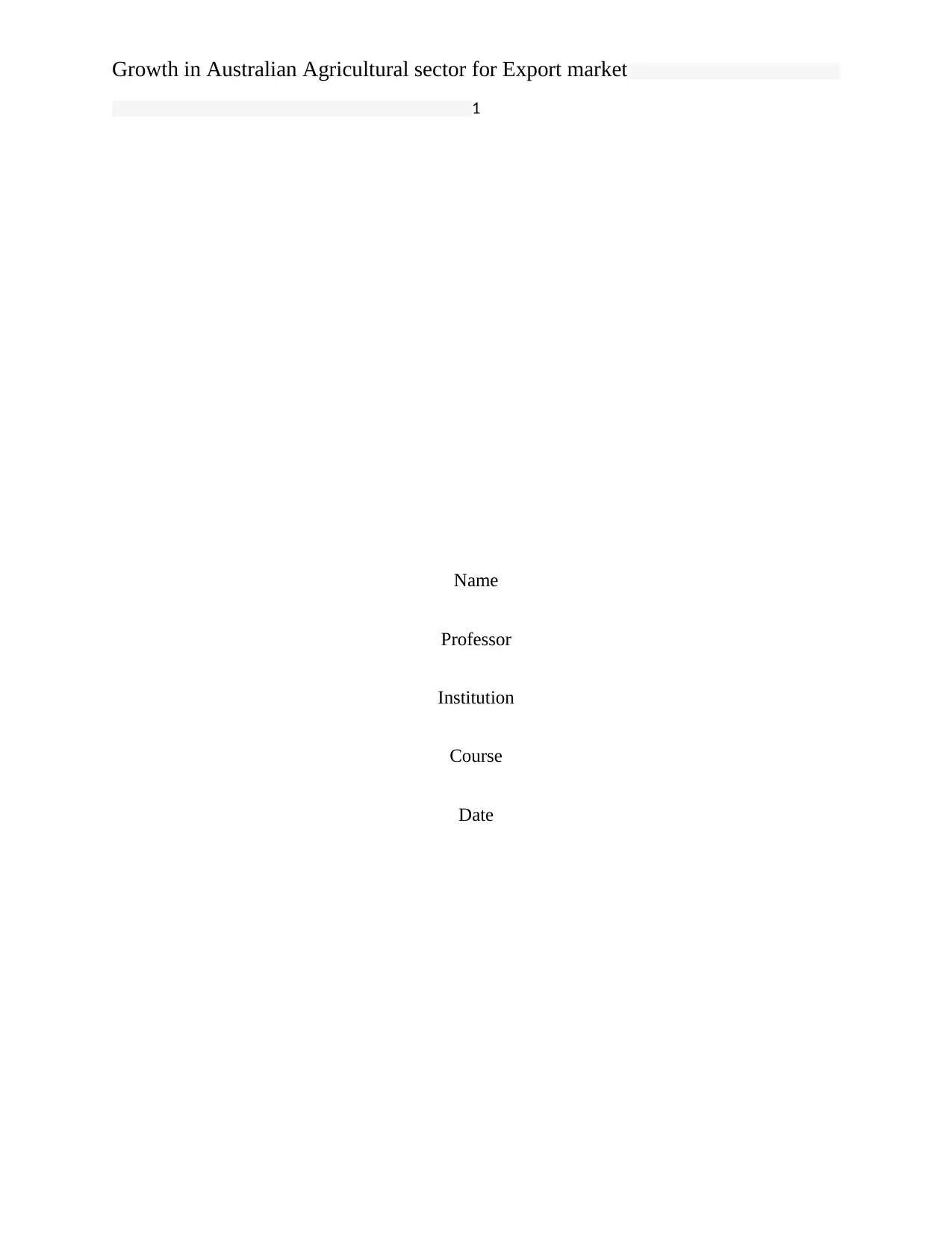
Growth in Australian Agricultural sector for Export market
1
Name
Professor
Institution
Course
Date
1
Name
Professor
Institution
Course
Date
Secure Best Marks with AI Grader
Need help grading? Try our AI Grader for instant feedback on your assignments.
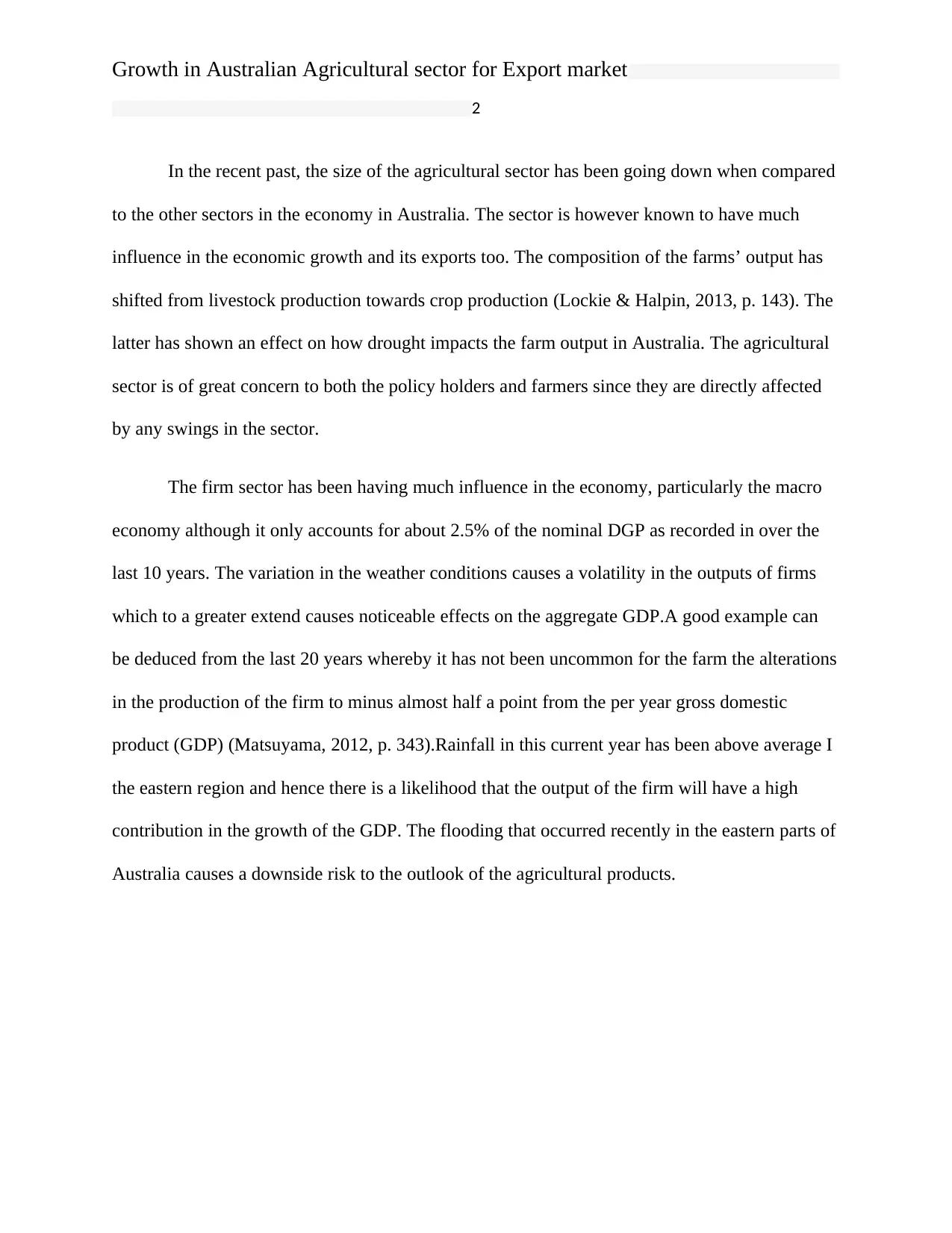
Growth in Australian Agricultural sector for Export market
2
In the recent past, the size of the agricultural sector has been going down when compared
to the other sectors in the economy in Australia. The sector is however known to have much
influence in the economic growth and its exports too. The composition of the farms’ output has
shifted from livestock production towards crop production (Lockie & Halpin, 2013, p. 143). The
latter has shown an effect on how drought impacts the farm output in Australia. The agricultural
sector is of great concern to both the policy holders and farmers since they are directly affected
by any swings in the sector.
The firm sector has been having much influence in the economy, particularly the macro
economy although it only accounts for about 2.5% of the nominal DGP as recorded in over the
last 10 years. The variation in the weather conditions causes a volatility in the outputs of firms
which to a greater extend causes noticeable effects on the aggregate GDP.A good example can
be deduced from the last 20 years whereby it has not been uncommon for the farm the alterations
in the production of the firm to minus almost half a point from the per year gross domestic
product (GDP) (Matsuyama, 2012, p. 343).Rainfall in this current year has been above average I
the eastern region and hence there is a likelihood that the output of the firm will have a high
contribution in the growth of the GDP. The flooding that occurred recently in the eastern parts of
Australia causes a downside risk to the outlook of the agricultural products.
2
In the recent past, the size of the agricultural sector has been going down when compared
to the other sectors in the economy in Australia. The sector is however known to have much
influence in the economic growth and its exports too. The composition of the farms’ output has
shifted from livestock production towards crop production (Lockie & Halpin, 2013, p. 143). The
latter has shown an effect on how drought impacts the farm output in Australia. The agricultural
sector is of great concern to both the policy holders and farmers since they are directly affected
by any swings in the sector.
The firm sector has been having much influence in the economy, particularly the macro
economy although it only accounts for about 2.5% of the nominal DGP as recorded in over the
last 10 years. The variation in the weather conditions causes a volatility in the outputs of firms
which to a greater extend causes noticeable effects on the aggregate GDP.A good example can
be deduced from the last 20 years whereby it has not been uncommon for the farm the alterations
in the production of the firm to minus almost half a point from the per year gross domestic
product (GDP) (Matsuyama, 2012, p. 343).Rainfall in this current year has been above average I
the eastern region and hence there is a likelihood that the output of the firm will have a high
contribution in the growth of the GDP. The flooding that occurred recently in the eastern parts of
Australia causes a downside risk to the outlook of the agricultural products.
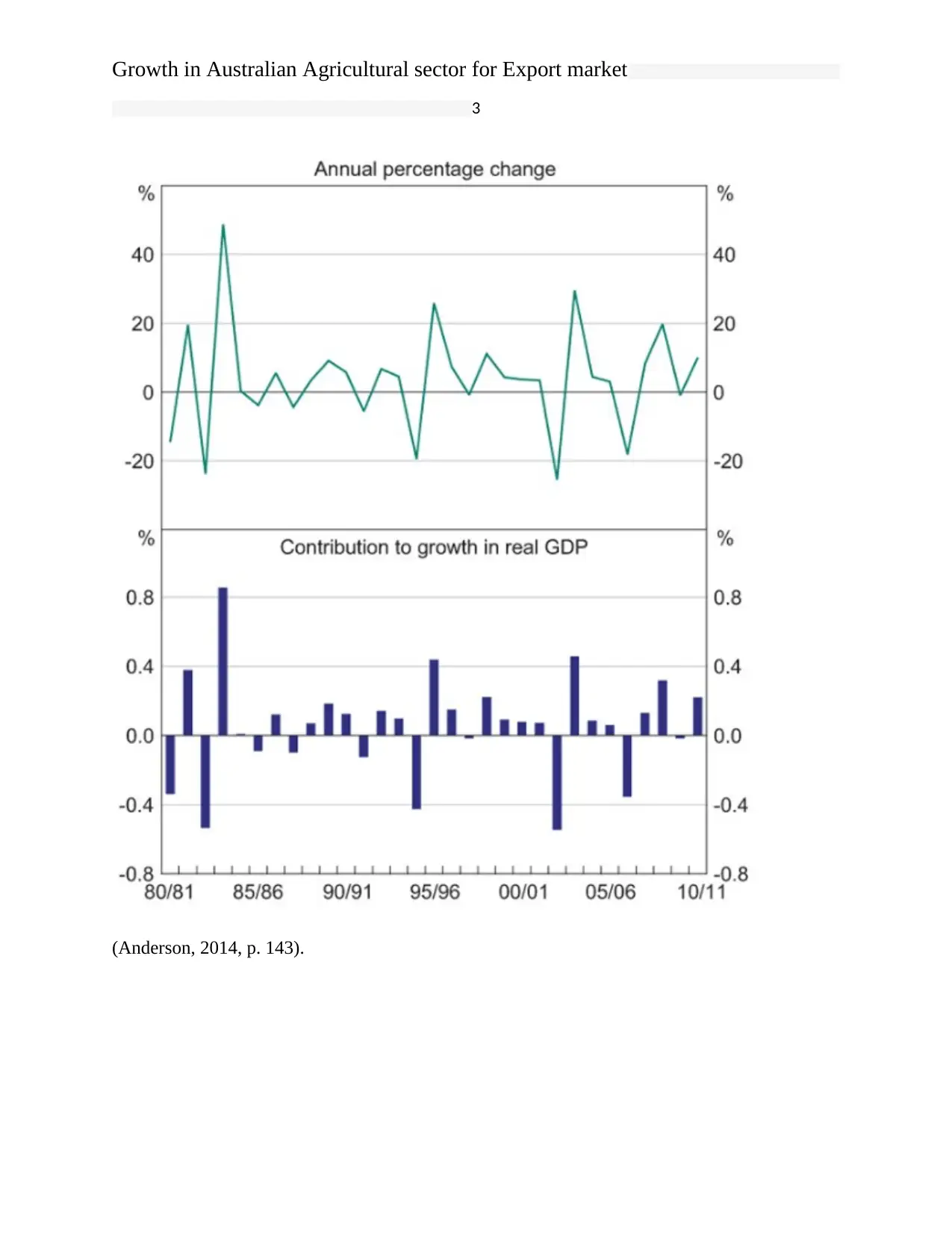
Growth in Australian Agricultural sector for Export market
3
(Anderson, 2014, p. 143).
3
(Anderson, 2014, p. 143).
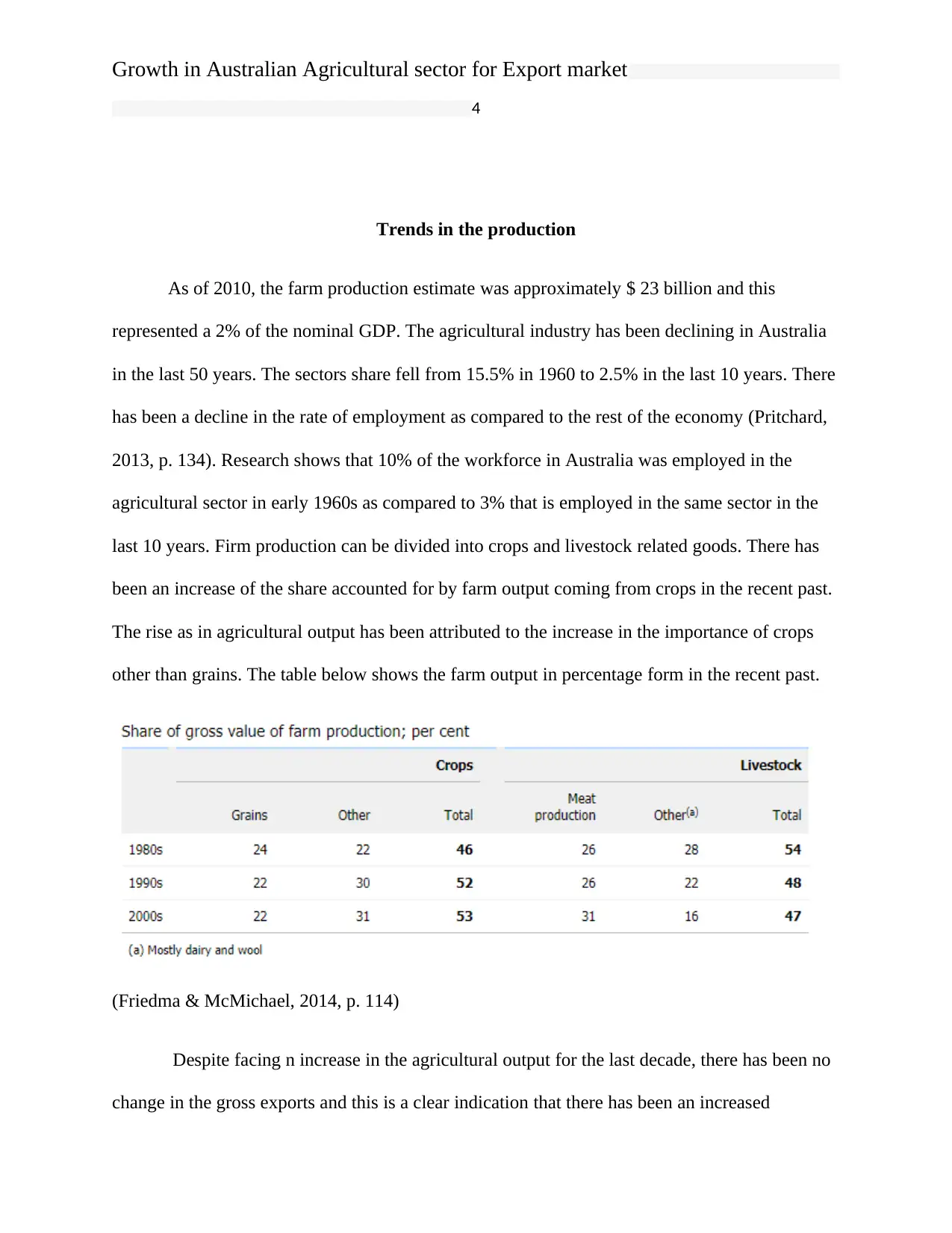
Growth in Australian Agricultural sector for Export market
4
Trends in the production
As of 2010, the farm production estimate was approximately $ 23 billion and this
represented a 2% of the nominal GDP. The agricultural industry has been declining in Australia
in the last 50 years. The sectors share fell from 15.5% in 1960 to 2.5% in the last 10 years. There
has been a decline in the rate of employment as compared to the rest of the economy (Pritchard,
2013, p. 134). Research shows that 10% of the workforce in Australia was employed in the
agricultural sector in early 1960s as compared to 3% that is employed in the same sector in the
last 10 years. Firm production can be divided into crops and livestock related goods. There has
been an increase of the share accounted for by farm output coming from crops in the recent past.
The rise as in agricultural output has been attributed to the increase in the importance of crops
other than grains. The table below shows the farm output in percentage form in the recent past.
(Friedma & McMichael, 2014, p. 114)
Despite facing n increase in the agricultural output for the last decade, there has been no
change in the gross exports and this is a clear indication that there has been an increased
4
Trends in the production
As of 2010, the farm production estimate was approximately $ 23 billion and this
represented a 2% of the nominal GDP. The agricultural industry has been declining in Australia
in the last 50 years. The sectors share fell from 15.5% in 1960 to 2.5% in the last 10 years. There
has been a decline in the rate of employment as compared to the rest of the economy (Pritchard,
2013, p. 134). Research shows that 10% of the workforce in Australia was employed in the
agricultural sector in early 1960s as compared to 3% that is employed in the same sector in the
last 10 years. Firm production can be divided into crops and livestock related goods. There has
been an increase of the share accounted for by farm output coming from crops in the recent past.
The rise as in agricultural output has been attributed to the increase in the importance of crops
other than grains. The table below shows the farm output in percentage form in the recent past.
(Friedma & McMichael, 2014, p. 114)
Despite facing n increase in the agricultural output for the last decade, there has been no
change in the gross exports and this is a clear indication that there has been an increased
Secure Best Marks with AI Grader
Need help grading? Try our AI Grader for instant feedback on your assignments.
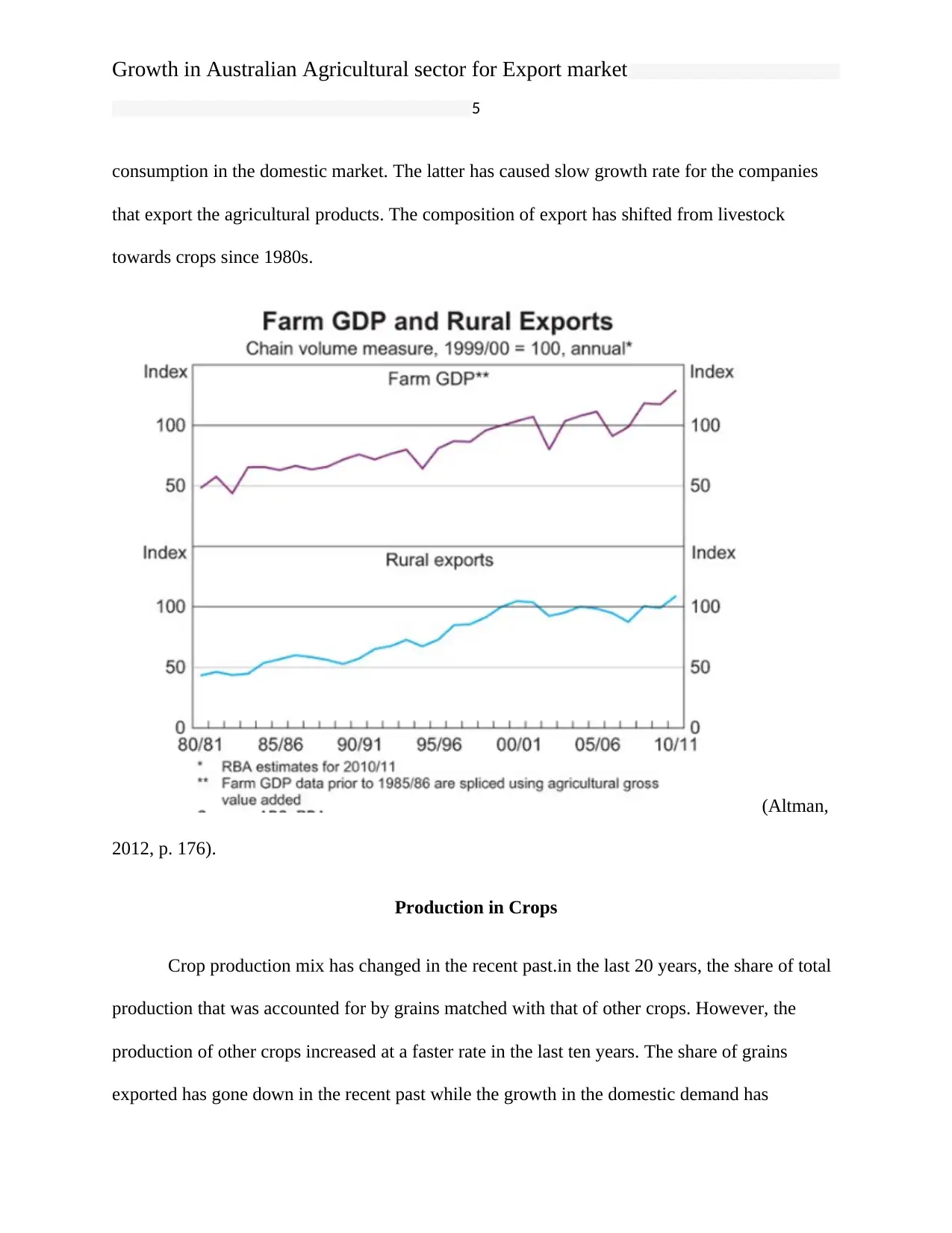
Growth in Australian Agricultural sector for Export market
5
consumption in the domestic market. The latter has caused slow growth rate for the companies
that export the agricultural products. The composition of export has shifted from livestock
towards crops since 1980s.
(Altman,
2012, p. 176).
Production in Crops
Crop production mix has changed in the recent past.in the last 20 years, the share of total
production that was accounted for by grains matched with that of other crops. However, the
production of other crops increased at a faster rate in the last ten years. The share of grains
exported has gone down in the recent past while the growth in the domestic demand has
5
consumption in the domestic market. The latter has caused slow growth rate for the companies
that export the agricultural products. The composition of export has shifted from livestock
towards crops since 1980s.
(Altman,
2012, p. 176).
Production in Crops
Crop production mix has changed in the recent past.in the last 20 years, the share of total
production that was accounted for by grains matched with that of other crops. However, the
production of other crops increased at a faster rate in the last ten years. The share of grains
exported has gone down in the recent past while the growth in the domestic demand has
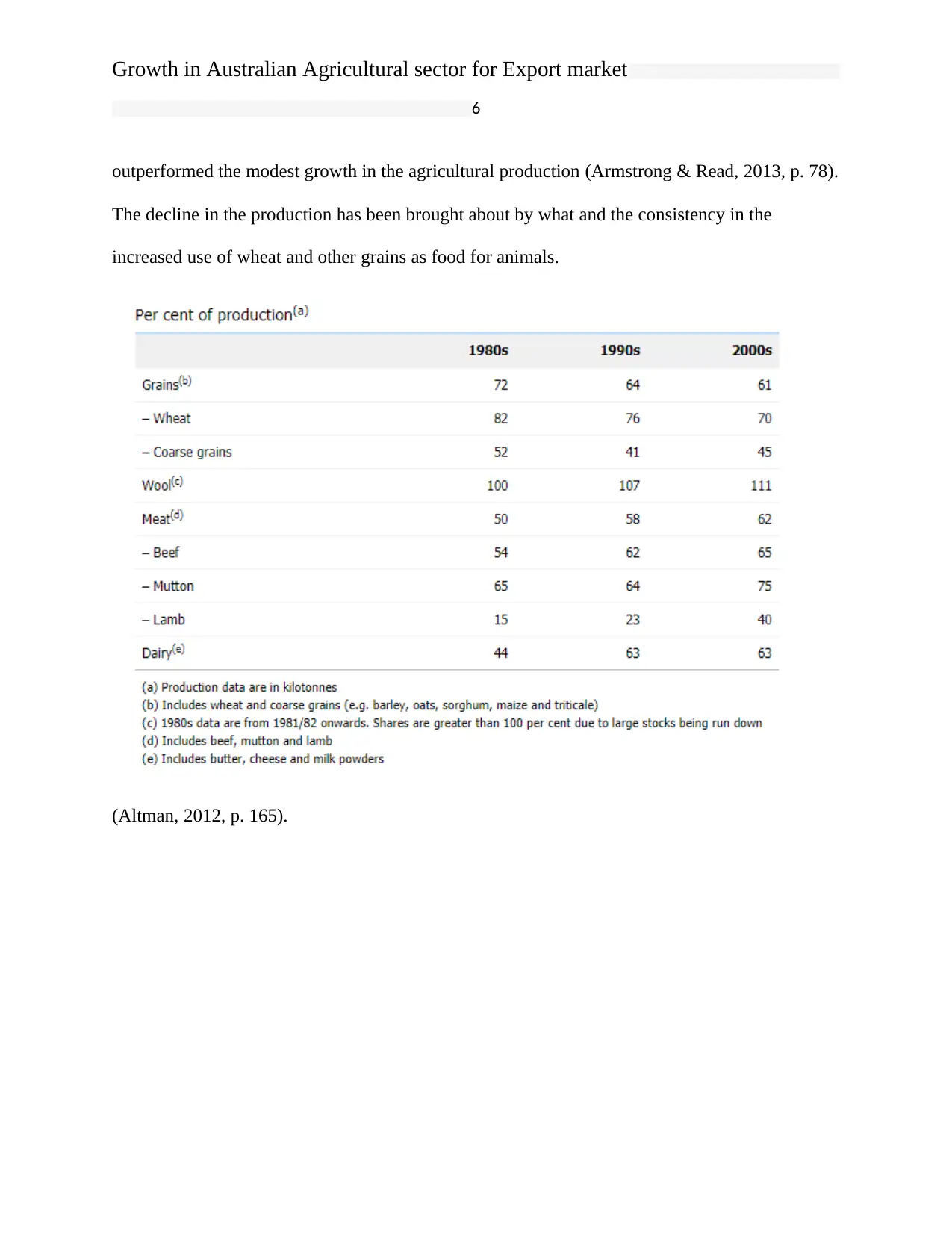
Growth in Australian Agricultural sector for Export market
6
outperformed the modest growth in the agricultural production (Armstrong & Read, 2013, p. 78).
The decline in the production has been brought about by what and the consistency in the
increased use of wheat and other grains as food for animals.
(Altman, 2012, p. 165).
6
outperformed the modest growth in the agricultural production (Armstrong & Read, 2013, p. 78).
The decline in the production has been brought about by what and the consistency in the
increased use of wheat and other grains as food for animals.
(Altman, 2012, p. 165).
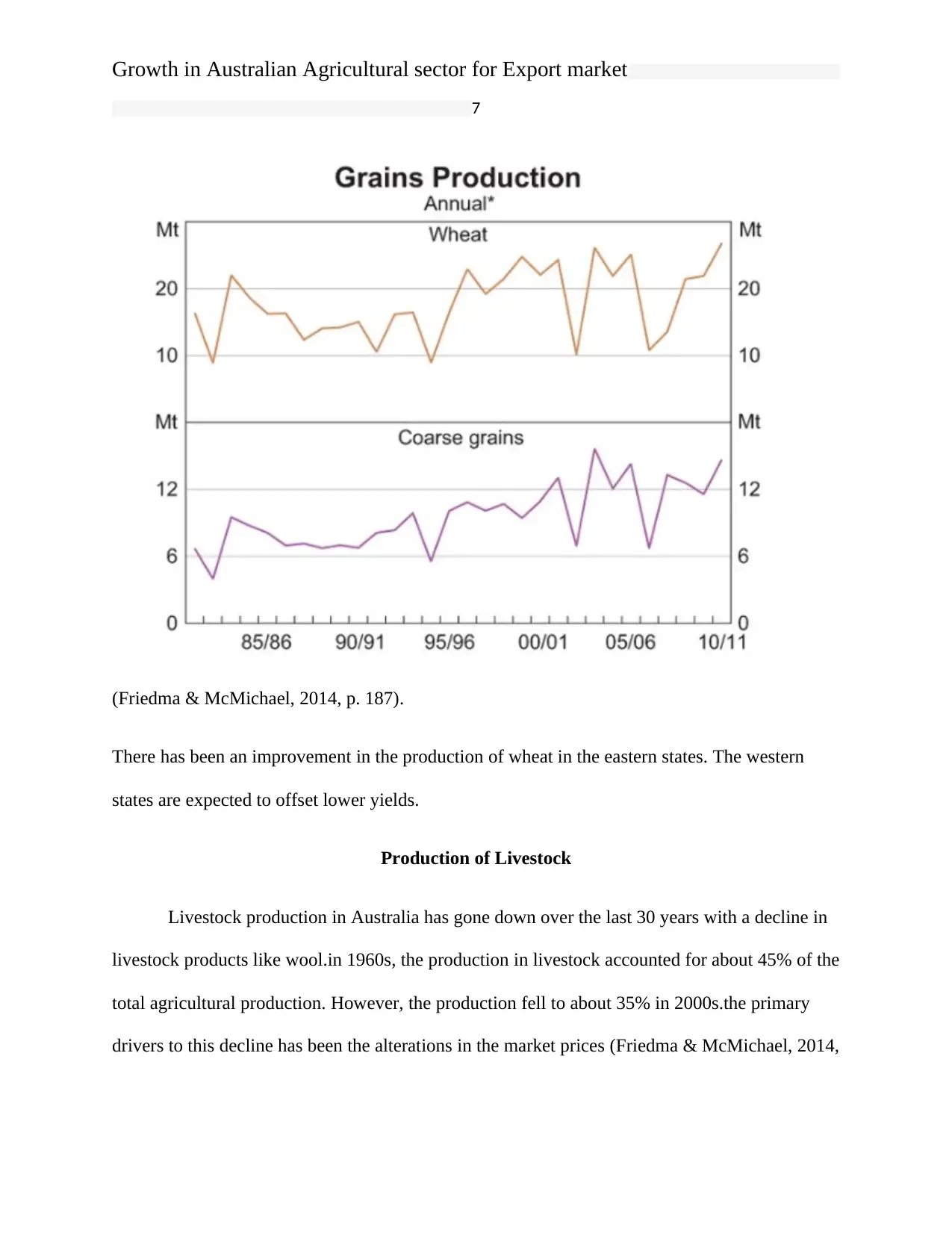
Growth in Australian Agricultural sector for Export market
7
(Friedma & McMichael, 2014, p. 187).
There has been an improvement in the production of wheat in the eastern states. The western
states are expected to offset lower yields.
Production of Livestock
Livestock production in Australia has gone down over the last 30 years with a decline in
livestock products like wool.in 1960s, the production in livestock accounted for about 45% of the
total agricultural production. However, the production fell to about 35% in 2000s.the primary
drivers to this decline has been the alterations in the market prices (Friedma & McMichael, 2014,
7
(Friedma & McMichael, 2014, p. 187).
There has been an improvement in the production of wheat in the eastern states. The western
states are expected to offset lower yields.
Production of Livestock
Livestock production in Australia has gone down over the last 30 years with a decline in
livestock products like wool.in 1960s, the production in livestock accounted for about 45% of the
total agricultural production. However, the production fell to about 35% in 2000s.the primary
drivers to this decline has been the alterations in the market prices (Friedma & McMichael, 2014,
Paraphrase This Document
Need a fresh take? Get an instant paraphrase of this document with our AI Paraphraser
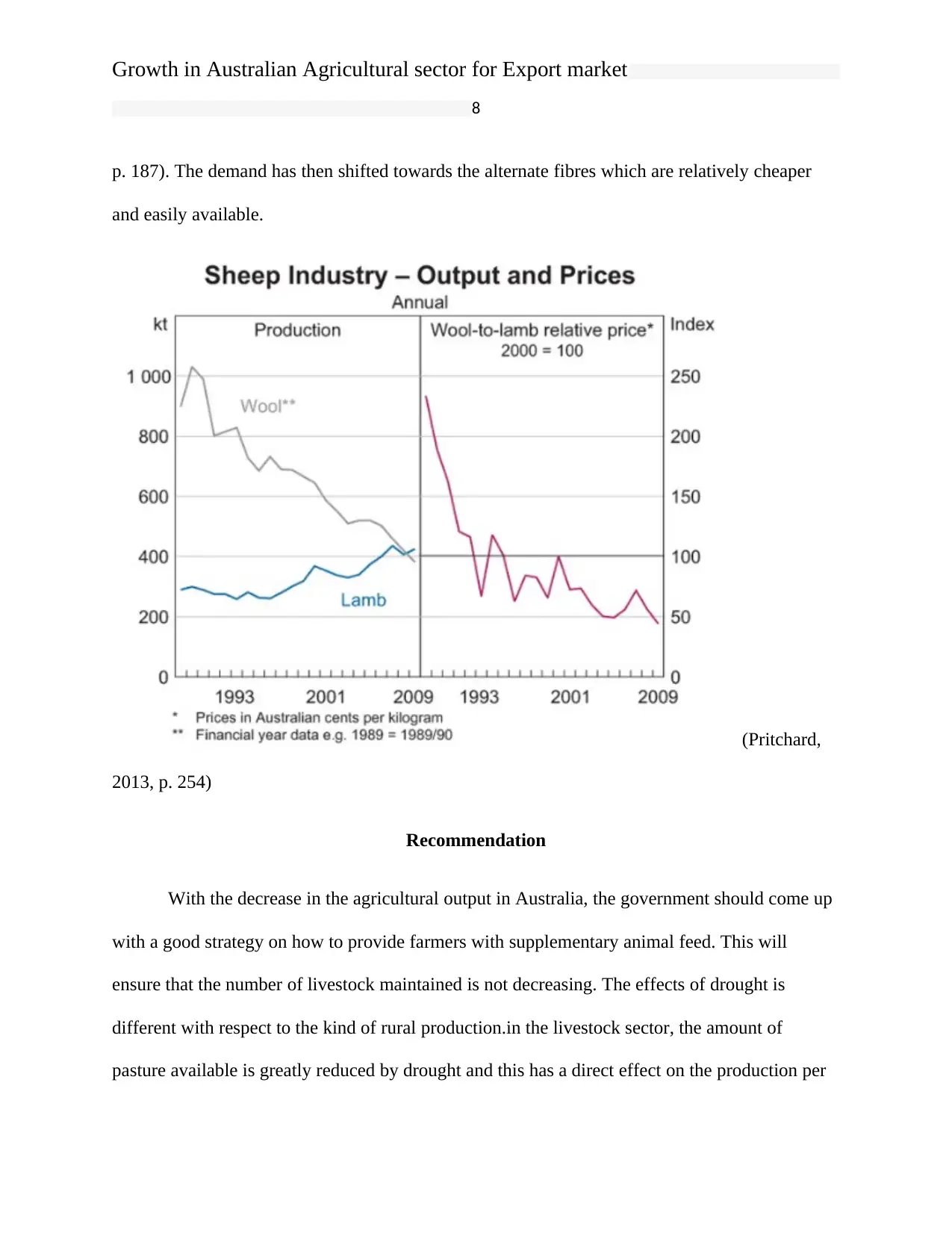
Growth in Australian Agricultural sector for Export market
8
p. 187). The demand has then shifted towards the alternate fibres which are relatively cheaper
and easily available.
(Pritchard,
2013, p. 254)
Recommendation
With the decrease in the agricultural output in Australia, the government should come up
with a good strategy on how to provide farmers with supplementary animal feed. This will
ensure that the number of livestock maintained is not decreasing. The effects of drought is
different with respect to the kind of rural production.in the livestock sector, the amount of
pasture available is greatly reduced by drought and this has a direct effect on the production per
8
p. 187). The demand has then shifted towards the alternate fibres which are relatively cheaper
and easily available.
(Pritchard,
2013, p. 254)
Recommendation
With the decrease in the agricultural output in Australia, the government should come up
with a good strategy on how to provide farmers with supplementary animal feed. This will
ensure that the number of livestock maintained is not decreasing. The effects of drought is
different with respect to the kind of rural production.in the livestock sector, the amount of
pasture available is greatly reduced by drought and this has a direct effect on the production per
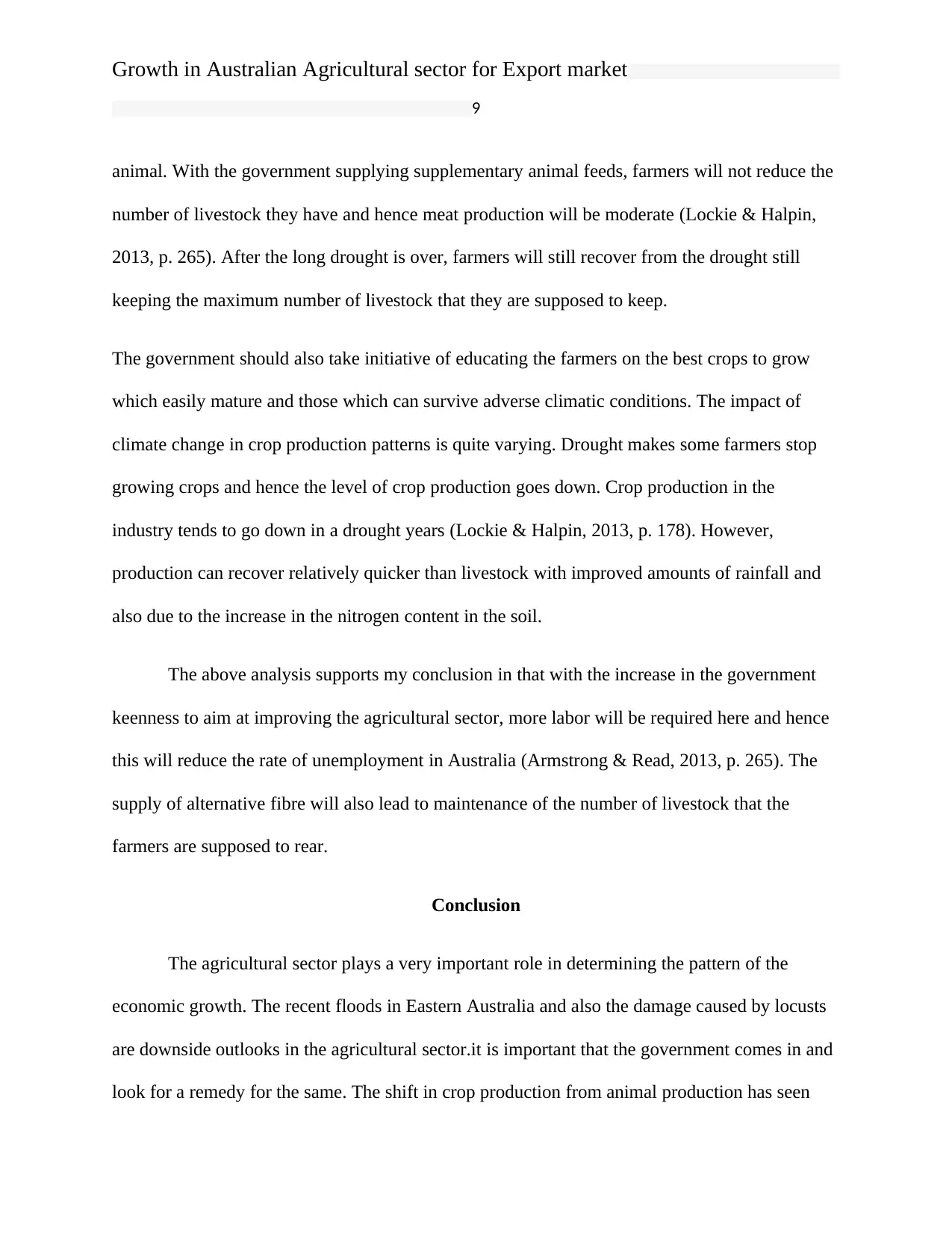
Growth in Australian Agricultural sector for Export market
9
animal. With the government supplying supplementary animal feeds, farmers will not reduce the
number of livestock they have and hence meat production will be moderate (Lockie & Halpin,
2013, p. 265). After the long drought is over, farmers will still recover from the drought still
keeping the maximum number of livestock that they are supposed to keep.
The government should also take initiative of educating the farmers on the best crops to grow
which easily mature and those which can survive adverse climatic conditions. The impact of
climate change in crop production patterns is quite varying. Drought makes some farmers stop
growing crops and hence the level of crop production goes down. Crop production in the
industry tends to go down in a drought years (Lockie & Halpin, 2013, p. 178). However,
production can recover relatively quicker than livestock with improved amounts of rainfall and
also due to the increase in the nitrogen content in the soil.
The above analysis supports my conclusion in that with the increase in the government
keenness to aim at improving the agricultural sector, more labor will be required here and hence
this will reduce the rate of unemployment in Australia (Armstrong & Read, 2013, p. 265). The
supply of alternative fibre will also lead to maintenance of the number of livestock that the
farmers are supposed to rear.
Conclusion
The agricultural sector plays a very important role in determining the pattern of the
economic growth. The recent floods in Eastern Australia and also the damage caused by locusts
are downside outlooks in the agricultural sector.it is important that the government comes in and
look for a remedy for the same. The shift in crop production from animal production has seen
9
animal. With the government supplying supplementary animal feeds, farmers will not reduce the
number of livestock they have and hence meat production will be moderate (Lockie & Halpin,
2013, p. 265). After the long drought is over, farmers will still recover from the drought still
keeping the maximum number of livestock that they are supposed to keep.
The government should also take initiative of educating the farmers on the best crops to grow
which easily mature and those which can survive adverse climatic conditions. The impact of
climate change in crop production patterns is quite varying. Drought makes some farmers stop
growing crops and hence the level of crop production goes down. Crop production in the
industry tends to go down in a drought years (Lockie & Halpin, 2013, p. 178). However,
production can recover relatively quicker than livestock with improved amounts of rainfall and
also due to the increase in the nitrogen content in the soil.
The above analysis supports my conclusion in that with the increase in the government
keenness to aim at improving the agricultural sector, more labor will be required here and hence
this will reduce the rate of unemployment in Australia (Armstrong & Read, 2013, p. 265). The
supply of alternative fibre will also lead to maintenance of the number of livestock that the
farmers are supposed to rear.
Conclusion
The agricultural sector plays a very important role in determining the pattern of the
economic growth. The recent floods in Eastern Australia and also the damage caused by locusts
are downside outlooks in the agricultural sector.it is important that the government comes in and
look for a remedy for the same. The shift in crop production from animal production has seen
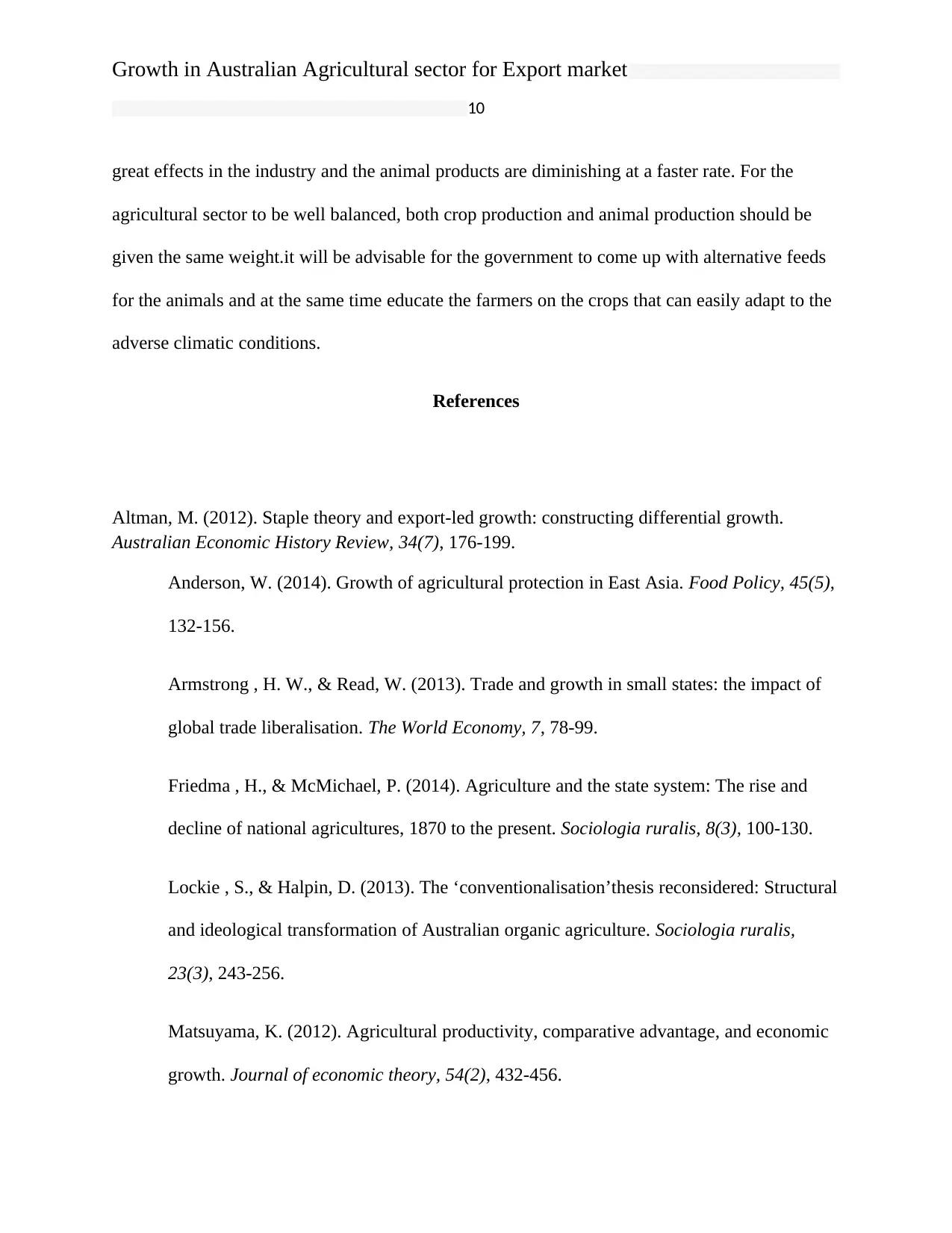
Growth in Australian Agricultural sector for Export market
10
great effects in the industry and the animal products are diminishing at a faster rate. For the
agricultural sector to be well balanced, both crop production and animal production should be
given the same weight.it will be advisable for the government to come up with alternative feeds
for the animals and at the same time educate the farmers on the crops that can easily adapt to the
adverse climatic conditions.
References
Altman, M. (2012). Staple theory and export‐led growth: constructing differential growth.
Australian Economic History Review, 34(7), 176-199.
Anderson, W. (2014). Growth of agricultural protection in East Asia. Food Policy, 45(5),
132-156.
Armstrong , H. W., & Read, W. (2013). Trade and growth in small states: the impact of
global trade liberalisation. The World Economy, 7, 78-99.
Friedma , H., & McMichael, P. (2014). Agriculture and the state system: The rise and
decline of national agricultures, 1870 to the present. Sociologia ruralis, 8(3), 100-130.
Lockie , S., & Halpin, D. (2013). The ‘conventionalisation’thesis reconsidered: Structural
and ideological transformation of Australian organic agriculture. Sociologia ruralis,
23(3), 243-256.
Matsuyama, K. (2012). Agricultural productivity, comparative advantage, and economic
growth. Journal of economic theory, 54(2), 432-456.
10
great effects in the industry and the animal products are diminishing at a faster rate. For the
agricultural sector to be well balanced, both crop production and animal production should be
given the same weight.it will be advisable for the government to come up with alternative feeds
for the animals and at the same time educate the farmers on the crops that can easily adapt to the
adverse climatic conditions.
References
Altman, M. (2012). Staple theory and export‐led growth: constructing differential growth.
Australian Economic History Review, 34(7), 176-199.
Anderson, W. (2014). Growth of agricultural protection in East Asia. Food Policy, 45(5),
132-156.
Armstrong , H. W., & Read, W. (2013). Trade and growth in small states: the impact of
global trade liberalisation. The World Economy, 7, 78-99.
Friedma , H., & McMichael, P. (2014). Agriculture and the state system: The rise and
decline of national agricultures, 1870 to the present. Sociologia ruralis, 8(3), 100-130.
Lockie , S., & Halpin, D. (2013). The ‘conventionalisation’thesis reconsidered: Structural
and ideological transformation of Australian organic agriculture. Sociologia ruralis,
23(3), 243-256.
Matsuyama, K. (2012). Agricultural productivity, comparative advantage, and economic
growth. Journal of economic theory, 54(2), 432-456.
Secure Best Marks with AI Grader
Need help grading? Try our AI Grader for instant feedback on your assignments.
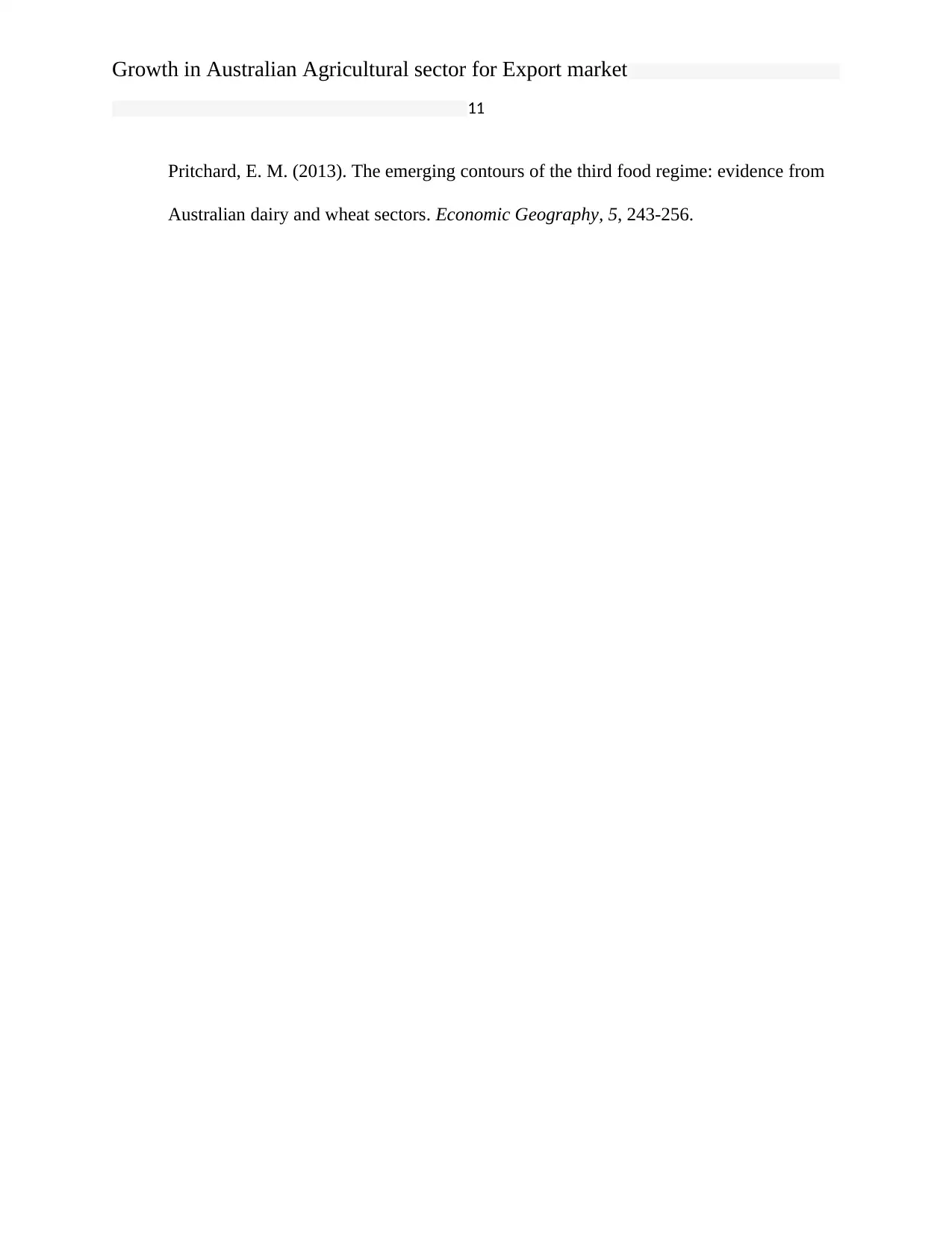
Growth in Australian Agricultural sector for Export market
11
Pritchard, E. M. (2013). The emerging contours of the third food regime: evidence from
Australian dairy and wheat sectors. Economic Geography, 5, 243-256.
11
Pritchard, E. M. (2013). The emerging contours of the third food regime: evidence from
Australian dairy and wheat sectors. Economic Geography, 5, 243-256.
1 out of 11
Related Documents
Your All-in-One AI-Powered Toolkit for Academic Success.
+13062052269
info@desklib.com
Available 24*7 on WhatsApp / Email
![[object Object]](/_next/static/media/star-bottom.7253800d.svg)
Unlock your academic potential
© 2024 | Zucol Services PVT LTD | All rights reserved.





